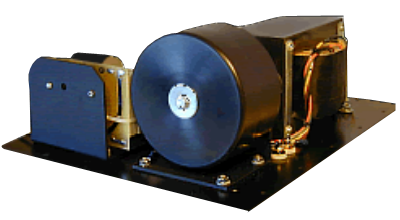
The reason transformers are used in our electrostatic speakers: A high charge density is required to create a force of sufficient strength to move the membrane of an electrostatic speaker. The force applied to the membrane is the algebraic product of the static charge on the membrane and the signal charge applied to the stator electrodes. To obtain acceptable sound levels both the static charge and the signal charge need to be high. A control is provided on the electronic backplate to permit adjusting the static membrane charge (bias power supply) to it’s practical maximum, which is where a low-level crackling sound is emitted from the panel. The proper adjustment is just below the threshold of this noise.
Concerning the signal charge, the output voltage of standard power amplifiers is not adequate to provide a charge magnitude necessary for proper speaker performance. To accompolish this, a high-quality audio step-up transformer is connected to the output of power amplifier to boost the signal to an adequate level.
For those not familiar with magnetic transformers: Transformers are devices that consist of two or more coils of wire that are wound on a common magnetically conductive material (the core). When an alternating signal is applied to the input coil (primary winding) current flows in the coil and creates a magnetic flux that flows through the core and engages the other coil(s) in which it magnetically induces a voltage having the same signal pattern as that applied to the input coil.
If the output coil (secondary coil) has more turns than the input coil the output voltage is greater than the input voltage, and the transformer is referred to as a “step-up” transformer. This is the type used to boost the signal in the electrostatic speaker.
Which type of transformer is best? There are many choices of core and winding materials and geometries. The best choice from among these for high-quality audio would have the least signal losses and the lowest inherent distortion characteristic. It should have the greatest sensitivity so that very small signals will be adequately coupled between primary and secondary windings. It should be able to transfer power signal levels without audible distortion. There is one transformer configuration that dramatically stands out from the rest, the toroid core.
Why is the toroid core configuration the optimum choice? The core used in our toroidal transformers is essentially a long strip of magnetic material rolled up into a coil. There are no air gaps in the core as it is continuous. Air gaps are the enemy to tight and accurate coupling between the primary and secondary coils. All other available core types necessarily have air gaps and therefore cannot provide the high degree of coupling demanded for high-end audio.
The primary and secondary wire is looped through the center hole of the core, around the core and back through the hole, etc., to form a coil. This approach provides the least losses and the tightest coupling possible since the core is one piece rather than a magnetically leaky stack of separate pieces as with other core configurations.
The sound of the toroid: Aside from the rather stodgy technical description of the toroidal transformer given above, I’m certain that a music lover is undoubtedly more interested in how the speaker sounds. So, how do they sound?
Since the toroidal core requires less energy to produce magnetic coupling between coils, it provides the ultimate in low-level signal resolution and signal purity. Delicate sounds are significantly more realistic using toroidal technology. For example, the decay of acoustic energy in a music hall following a loud passage seems to reduce in level seemingly forever. The toroid accurately preserves this effect, which would be missing using other core configurations.
Furthermore, the nuances of overtones are much more apparent and add greater realism, such as the breathiness of the voice or the surface texture of a stringed instrument. These approach that of the original sound.
Recording engineers have mentioned to us that by using our toroidal technology they have heard very low-level extraneous sounds outside the recording studio never detected before in their recordings such as traffic, dogs barking, aircraft flying over, etc. More than one reviewer has told us that we should never use anything but toroidal technology in our speakers.
Finale: The toroidal transformer provides the necessary high voltage signal magnification without making compromises that would degrade sound quality. Sound subtleties, which give the aura of “being there”, are preserved.